
Frans van Mieris the Elder stands as one of the most accomplished and celebrated painters of the Dutch Golden Age. Active primarily in Leiden, he became a leading figure of the local school of "fijnschilders," or fine painters, renowned for their extraordinarily detailed techniques, smooth surfaces, and intimate depictions of Dutch life. Born on April 16, 1635, and passing away on March 12, 1681, Van Mieris compressed a remarkably productive and influential career into his relatively short life, leaving behind a legacy of exquisite artworks that continue to captivate viewers with their technical brilliance and subtle narratives.
Early Life and Artistic Inclinations
Frans van Mieris was born into an artistic family in Leiden, a bustling center of trade, academia, and art in the 17th-century Dutch Republic. His father, Jan Bastiaansz. van Mieris, was a goldsmith, jeweler, and diamond setter, suggesting an environment where craftsmanship and attention to detail were highly valued. Initially, Frans was expected to follow in his father's footsteps, learning the intricate skills of metalwork and gem setting. However, his innate talent and passion for drawing and painting soon became evident, leading him to pursue a career in the visual arts instead.
His earliest formal training in art was reportedly with the glass painter Abraham Torenvliet, though this connection might have been brief. The decisive step in his artistic education came when he entered the studio of Gerrit Dou (also known as Gerard Dou), who was himself Leiden's most famous painter and a former pupil of the great Rembrandt van Rijn. This apprenticeship proved pivotal in shaping Van Mieris's future direction.
The Influence of Gerrit Dou and the Leiden School
Gerrit Dou was the founding father of the Leiden school of "fijnschilders." His style was characterized by meticulous detail, an enamel-like finish that concealed visible brushstrokes, and often small-scale compositions depicting domestic scenes, scholars, or tradespeople, frequently illuminated by candlelight or soft daylight. Dou recognized the exceptional talent of his young pupil, famously referring to Van Mieris as the "prince of his pupils." Under Dou's tutelage, Van Mieris absorbed the core tenets of the fijnschilder technique: precision, patience, and the pursuit of illusionistic perfection.
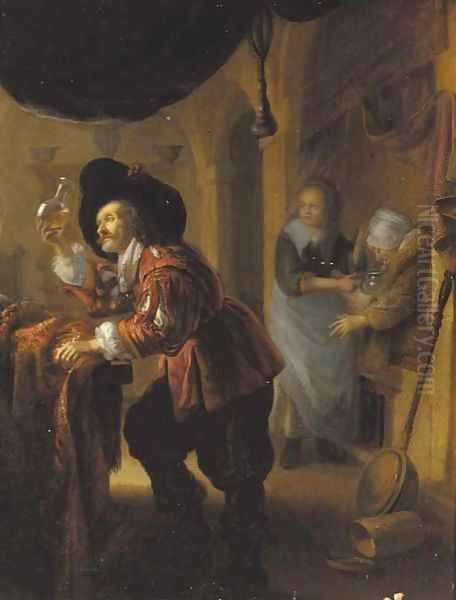
While Dou's influence remained fundamental, Van Mieris also sought further instruction to broaden his skills. He spent some time studying with Abraham van den Tempel, a respected portrait and history painter active in Leiden and later Amsterdam. While Van den Tempel's style was generally broader than Dou's, this experience may have contributed to Van Mieris's confidence in handling different genres, including portraiture, although he ultimately remained most dedicated to the highly polished finish associated with the fijnschilder tradition.
By 1658, Frans van Mieris was accomplished enough to enroll as an independent master in the Leiden Guild of Saint Luke, the professional organization for painters and other craftsmen. This marked the official beginning of his independent career, during which he quickly established himself as one of the city's most sought-after artists.
The Quintessential Fijnschilder Style
Frans van Mieris the Elder epitomizes the Leiden fijnschilder aesthetic. His paintings are typically small, often executed on wood panel or sometimes copper, supports that facilitate a smooth, detailed application of paint. The hallmark of his style is the astonishing level of detail and the illusionistic rendering of textures. He possessed an uncanny ability to depict the sheen of satin, the softness of velvet, the glint of metal, the transparency of glass, and the texture of fur or feathers with breathtaking realism.
His technique involved the use of very fine brushes and the careful layering of thin glazes of oil paint. This allowed him to achieve subtle gradations of tone and color, creating a luminous quality and a surface almost entirely free of visible brushwork. The effect is one of polished perfection, inviting close inspection by the viewer. His palette often featured rich, warm colors, contributing to the intimate and often luxurious atmosphere of his scenes.
Compared to his master Gerrit Dou, Van Mieris often depicted scenes with slightly more complex figure arrangements and a greater sense of interaction between the characters. While Dou frequently focused on single figures in quiet contemplation or activity, Van Mieris excelled at small group scenes imbued with narrative potential, often related to courtship, music, or social visits.
Themes and Subjects in Van Mieris's Oeuvre
Van Mieris's subject matter primarily revolved around genre scenes, depicting the activities and interiors of the prosperous Dutch middle and upper classes. These scenes often carry subtle narrative or symbolic meanings, reflecting contemporary social customs, moral ideas, or allegorical concepts.
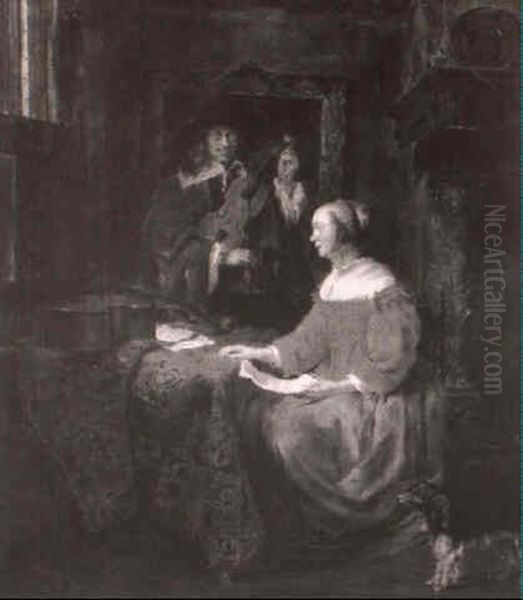
Elegant interiors are a common setting, showcasing well-appointed rooms with fine furniture, musical instruments, paintings on the walls, and characters dressed in fashionable attire. Music-making scenes, such as The Duet, were popular, often symbolizing harmony or serving as a backdrop for courtship rituals. The depiction of amorous themes, sometimes subtle and sometimes more overt, was a recurring element in his work.
Another favored theme was the "doctor's visit," exemplified by his famous painting The Doctor's Visit (1657). These scenes typically show a physician attending to a pale young woman, often interpreted as suffering from "lovesickness," a common trope in Dutch art reflecting contemporary ideas about medicine and emotion. Van Mieris rendered these intimate moments with psychological nuance and exquisite detail in the setting and costumes.
He also painted portraits, often small-scale and executed with the same meticulous finish as his genre scenes. Additionally, he produced some allegorical works, such as A Boy Blowing Bubbles (1663), a classic vanitas image symbolizing the transience of life and earthly pleasures. Biblical subjects, like Tobias and the Angel, also appear in his oeuvre, treated with his characteristic refinement. Self-portraits provide glimpses into the artist's own persona, sometimes depicting him in the guise of a merry drinker or a refined gentleman.
Masterpieces and Representative Works
Several paintings stand out as defining examples of Frans van Mieris's skill and thematic interests:
_The Doctor's Visit_ (1657, Kunsthistorisches Museum, Vienna): This early masterpiece showcases his ability to combine detailed realism with narrative suggestion. The concerned doctor, the languid patient, the richly furnished room, and the symbolic details (like a statue of Cupid) all contribute to the scene's complex meaning. The rendering of the fabrics, particularly the patient's satin jacket, is exceptional.
_The Duet_ (1658, Staatliches Museum Schwerin): A quintessential example of his elegant genre scenes. It depicts a man playing a theorbo while a woman prepares to sing from a sheet of music, seated at a virginal. The intimate atmosphere, the luxurious details of the interior, and the masterful handling of light and texture make it a prime example of Dutch Golden Age genre painting.
_A Cavalier in the Shop_ (also known as _The Cloth Shop_) (c. 1660, Kunsthistorisches Museum, Vienna): This work depicts a finely dressed gentleman interacting with a shopkeeper, examining fabrics. It offers a glimpse into the world of commerce and consumption among the wealthy, rendered with Van Mieris's typical precision in depicting textiles and surfaces.
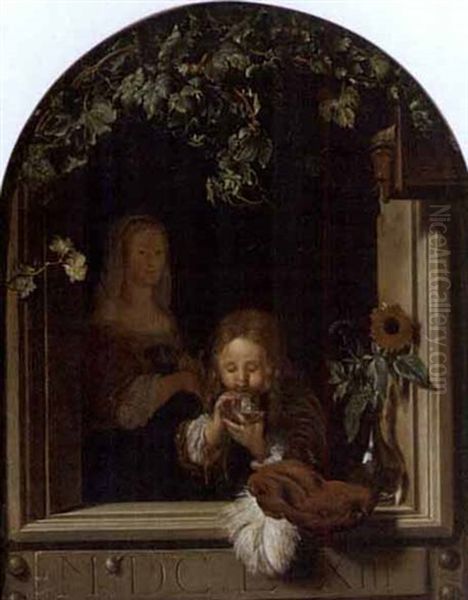
_A Boy Blowing Bubbles_ (1663, Mauritshuis, The Hague): This small panel is a poignant vanitas allegory. The boy, engrossed in the fleeting beauty of a soap bubble, stands beside symbols of transience like a skull and an hourglass. The technical challenge of painting the iridescent, transparent bubble is met with remarkable skill.
_Family Concert_ (1675, Uffizi Gallery, Florence): Painted later in his career, this work shows a group, likely representing an idealized family or social gathering, engaged in making music. The composition is more complex than some of his earlier works, demonstrating his continued mastery of group dynamics and detailed settings.
_Trompe l’oeil with a Garland of Flowers and a Curtain_ (1658, Art Institute of Chicago): This intriguing work is a collaboration with the flower painter Adriaen van der Spelt. Van der Spelt painted the exquisite floral garland, while Van Mieris is credited with painting the illusionistic blue curtain that appears to be partially drawn back, revealing the flowers. It is a masterful example of trompe l'oeil ("deceive the eye") painting, a genre popular in the Dutch Golden Age.
Patronage, Reputation, and Personal Life
Frans van Mieris achieved considerable fame during his lifetime. His works commanded high prices and were sought after by discerning collectors both within the Dutch Republic and abroad. His patrons included wealthy Leiden citizens, such as the professor and collector Florentius Schuyl. His reputation extended to international circles; notably, Cosimo III de' Medici, Grand Duke of Tuscany, visited his studio during his trip to the Netherlands in 1669 and acquired several works, contributing to Van Mieris's presence in the prestigious Florentine collections (like the Uffizi).
Despite his artistic success and the high prices his paintings fetched, Van Mieris seems to have struggled with financial management. Anecdotal accounts, recorded by the later artist biographer Arnold Houbraken, suggest a penchant for socializing and perhaps excessive drinking. One famous story recounts an incident in 1675 where Van Mieris, allegedly after drinking heavily, left a commissioned painting at a tavern. His wife, Cunera van der Cock, whom he had married in 1657 and with whom he had several children, reportedly had to intervene to ensure payment was secured. These stories paint a picture of a brilliant artist whose personal life may have been less orderly than his meticulously crafted paintings. His documented debts towards the end of his life lend credence to these accounts of financial difficulties.
Van Mieris in the Context of His Contemporaries
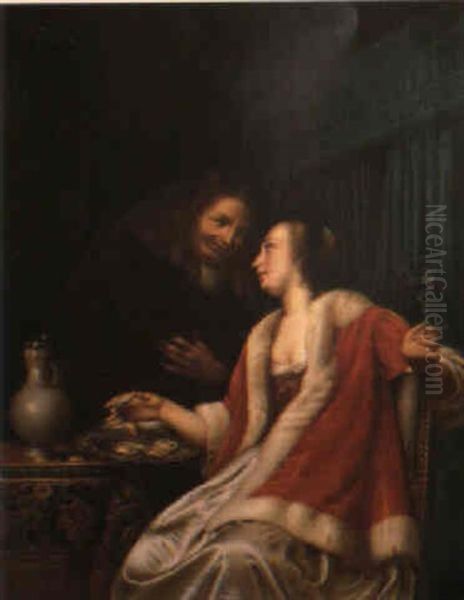
Frans van Mieris the Elder operated within a rich artistic landscape. His relationship with his teacher, Gerrit Dou (1), remained significant throughout his career, setting the standard for the Leiden fijnschilder style. Other Leiden painters working in a similar vein included Pieter Cornelisz van Slingelandt (2), known for perhaps even more painstaking detail, Godfried Schalcken (3), famous for his candlelit scenes, and Dou's nephew Domenicus van Tol (4).
Beyond Leiden, Van Mieris's work can be compared and contrasted with other leading Dutch genre painters. Gabriel Metsu (5), who also worked in Leiden for a time, shared an interest in elegant interior scenes but often employed a slightly looser, though still refined, technique. Gerard ter Borch (6), active mainly in Deventer, was another master of depicting textures, particularly satin, and excelled at capturing subtle psychological interactions in his quiet, aristocratic scenes. While Ter Borch might be seen as having a greater sense of understated elegance and psychological depth, Van Mieris arguably surpassed him in sheer technical virtuosity and surface brilliance. Eglon van der Neer (7) also specialized in highly polished scenes of elite life.
The influence also flowed in the other direction. The quality and desirability of Van Mieris's work were recognized by his peers. It is documented that major artists like Johannes Vermeer (8) and Jan Steen (9) owned paintings by Van Mieris, indicating the high esteem in which he was held by fellow masters. His collaboration with Adriaen van der Spelt (10) on the trompe l'oeil painting highlights the interactions within the artistic community. While generally more refined, some of his tavern or more animated scenes might show a distant echo of the earthier genre paintings by artists like Adriaen van Ostade (11), although Van Mieris consistently elevated his subjects with his polished technique.
Later Years and the Van Mieris Dynasty
Frans van Mieris continued to paint productively throughout the 1660s and 1670s, maintaining his high standards of quality. He served multiple terms as headman or dean of the Leiden Guild of Saint Luke, indicating his respected position within the local artistic community. However, his life was cut short. He died in Leiden on March 12, 1681, at the age of just 45. He was buried in the Pieterskerk, a prominent church in Leiden. The reasons for his relatively early death are not definitively known, but speculation often links it to his reputed lifestyle and financial stresses.
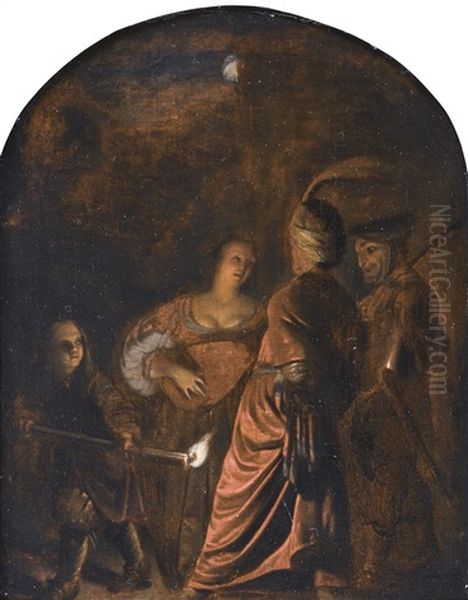
His artistic legacy was carried on directly by his sons, Jan van Mieris (12) (1660-1690) and, more significantly, Willem van Mieris (13) (1662-1747). Willem became a successful painter in his own right, closely following his father's fijnschilder style and themes, though perhaps lacking some of Frans the Elder's subtlety and vibrancy. Willem's son, Frans van Mieris the Younger (14) (1689-1763), also became a painter and antiquarian, continuing the family tradition into the mid-18th century, although his artistic output is generally considered less significant than that of his father and grandfather. This continuation established a veritable Van Mieris dynasty within the Leiden school.
Enduring Legacy and Art Historical Significance
Frans van Mieris the Elder remains a pivotal figure in Dutch Golden Age art. He stands alongside Gerrit Dou as the foremost exponent of the Leiden fijnschilder tradition. His technical mastery in rendering detail, texture, and light reached a level that few artists have ever equaled. His paintings offer invaluable visual records of the material culture, social customs, and aesthetic preferences of the Dutch elite during a period of unprecedented prosperity.
His influence extended beyond his immediate circle and family. The meticulous finish and intimate scale of his work appealed greatly to 18th-century tastes, ensuring his continued popularity among collectors long after his death. While the broader brushwork and more overt emotionalism favored by Romanticism and later movements led to a temporary decline in the critical estimation of the fijnschilders, the 20th and 21st centuries have seen a renewed appreciation for their extraordinary craftsmanship and their unique contribution to the diversity of Dutch art.
Today, Frans van Mieris the Elder is recognized not just for his technical prowess but also for his ability to infuse small-scale genre scenes with narrative interest and psychological nuance. His works are prized possessions of major museums worldwide, admired for their jewel-like quality, their intricate beauty, and their evocative portrayal of life in the Dutch Golden Age. He secured his place as a master whose dedication to the art of "fine painting" produced works of enduring fascination and unparalleled skill.
Conclusion
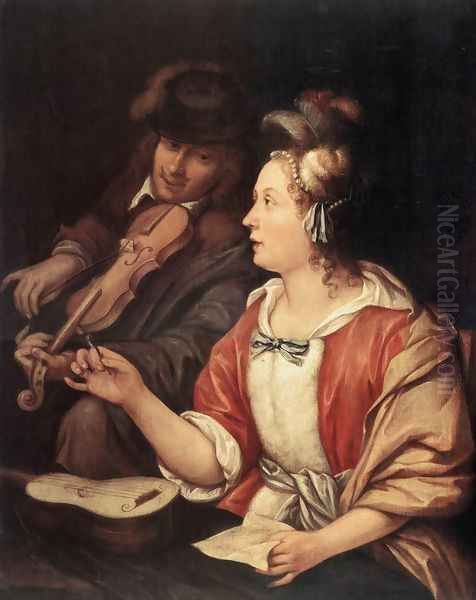
Frans van Mieris the Elder's career, though relatively brief, was marked by exceptional artistic achievement. As a leading Leiden fijnschilder, he perfected a style characterized by meticulous detail, smooth surfaces, and luminous depictions of texture. His intimate genre scenes, portraits, and allegories captured the refined world of the Dutch upper classes with unparalleled technical skill and subtle narrative depth. Despite personal challenges, his dedication to his craft resulted in a body of work that earned him fame during his lifetime and secured his reputation as one of the most brilliant painters of the Dutch Golden Age. Through his own masterpieces and the continuation of his style by his sons and grandson, Frans van Mieris left an indelible mark on the history of art.